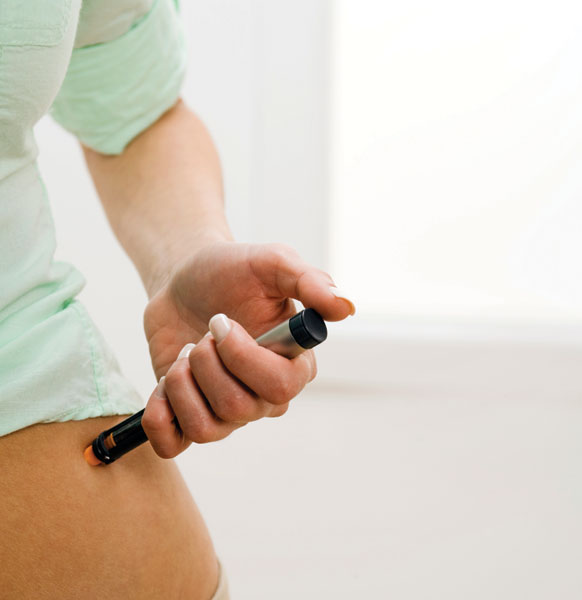There is no difference between a pen and a syringe in terms of blood glucose response. It’s a personal choice.
While it’s common to dread the thought of taking insulin, it’s also common to wonder why you resisted once you get started. If you feel down
33%
the estimated percentage of people with type 2 diabetes who take insulin, either alone or in combination with diabetes pills.
about taking insulin, it may help to remind yourself that taking insulin is not a sign that you failed to take care of yourself or that your diabetes has gotten worse.
It just means that your body needs insulin to keep your blood glucose levels in your target range.
Pens vs. syringes
Insulin can be given using either an insulin pen or a syringe. There are pluses and minuses for each. For many people, the biggest factor to consider is insurance coverage. Some insurers will not cover pens because of the cost. However, morecompanies cover pens now, so check with your insurance plan to find out if yours covers them.
If you often take insulin while you’re away from home, it may be easier to carry a pen rather than a vial of insulin and a syringe. On the other hand, if you take large doses of insulin it may be easier to use a syringe. Some people feel more secure when they use a syringe because they can see the insulin leaving the syringe.
Needles and syringes
The good news is that needles are now smaller and thinner than ever for both pens and syringes. This means injections are less painful. Needles that are between 4-6 mm (less than ¼-inch long) may be used by any adult, regardless of body weight. Be sure to give an air shot each time you use a new pen needle to make sure you get your complete dose.
There is no difference in syringes in terms of accuracy or comfort. Choose the syringe size that best matches your dose and is easiest for you to read. If you take doses that end in odd numbers, choose a syringe with 1-unit markings.
Giving your injection
You don’t need to clean the top of the vial or your skin with alcohol. Insulin is considered bacteriostatic, which means it’s very unlikely it will give you an infection.
Choose an injection site on your thighs, arms, buttocks or abdomen. Insulin is absorbed fastest from your abdomen.
Your blood glucose will be more stable if you stick with one area for each type of insulin. You do need to change your injection sites slightly each day to avoid getting lumps and bumps, which interfere with insulin absorption.
You don’t need to pinch an inch of skin. You can simply stick the needle straight in. With today’s shorter needles, there is almost no chance you will inject your insulin into a vein or muscle. The exceptions are children and very thin adults, who need to insert the needle at a 45-degree angle. Hold the needle in place for a count of 10 before pulling the needle out to be sure you are getting your full insulin dose.
Taking it with you
Unopened vials or pens can be kept in the refrigerator until the expiration date. Opened vials or the pen you are currently using don’t need to be refrigerated as long as they are at room temperature, or between 32º and 86ºF. If your insulin freezes, throw it out because it will not work at all. Insulin that has been overheated will be less effective. The time this is most likely to happen is when insulin is left in a car on a cold or hot day, on a window sill or in a steamy bathroom. You can buy an insulated container to keep your insulin at the right temperature away from home.
It is a good idea to think about when this is likely to happen so you can try to prevent it. It is very important to have effective insulin around when you need it. It may sound like a chore, but in the long run, it will make your life easier.
4
insulin facts
➊
Most people find that insulin shots are not as painful as they feared.
➋
If you find it painful or you often get bruises, ask your healthcare provider or educator to watch you inject yourself so he or she can offer advice.
➌
Some people find that pressing firmly on the injection site for a few seconds helps to ease the pain.
➍
Don’t worry if you see a drop of blood when you remove the needle. This does not mean that you have injected your insulin into a muscle or vein.
Study Findings and what the Experts Say
People who use pens are more likely to give the correct dose and are more satisfied with taking insulin.
Needles are designed to be used once, and they get dull with each use. If you decide to reuse the needle on your pen, change it at least once a day.
Make a plan for how to take your pre-meal insulin when away from home.

